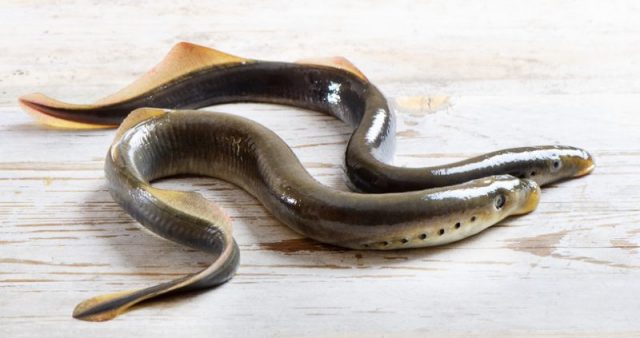It was a cherished delicacy that graced the tables of such royal epicures as Henry I, Henry VIII, and Charles II, so special it was served in a pie and sent to court for special occasions.
An alternative view is: It was a hideous sea monster, older than the dinosaurs.
Both may be true.

The lamprey is a primitive lineage of eel-like fish which is believed to be 360 million years old. It is bizarre looking, with its jawless mouth filled with tiny teeth, perfect for a vampiric draining of the blood of its victims.
When the larger form of the species has been caught by fishermen, its hideousness has earned it the name “sea monster.”

“Some species of lamprey are parasitic, feeding on other fish,” reported the Museum of London Archaeology (MOLA). “It may be hard to stomach, but lampreys were a popular delicacy among the nobility in medieval Britain (and continue to be eaten in Spain and Finland).”
But scientists had not been able to find evidence of the famous lamprey feasts of English royalty, despite its existence showing up in the historical records.

Live Science reports, “That may be because the skeletons inside lampreys’ eel-like bodies are made of cartilage and their teeth are made of keratin (the same stuff as hair and fingernails) — two materials that are not likely to be preserved after centuries buried underground.”
A breakthrough came when Alan Pipe, Senior Archaeozoologist at MOLA, took a close look at environmental samples from excavations near Mansion House station in London. The source was a cesspit, with the team estimating its use between 1270 and 1400.

“Almost everything we know about the popularity of lampreys in medieval England comes from historical accounts,” said Piper in a statement. “It is incredibly exciting, after 33 years of studying animal remains, to finally identify traces of the elusive lamprey at the heart of the historic City of London, preserved in the water-logged ground near the Thames.”
Once they were fairly common, but now the three species of lamprey found in the British Isles (brook, river and sea: two of which feed parasitically) are protected species.
Kings and queens of England loved lamprey so much, it proved fatal to one monarch, or so the story goes. Henry I had such a craving for lamprey that he ate them to death. His physician famously listed his cause of death as “a surfeit of lampreys.”

According to chronicler Roger of Wendover, Henry I “stopped at St. Denys in the wood of Lions to eat some Lampreys, a fish he was very fond of, thought they always disagreed with him, and the physicians had often cautioned him against eating them, but he would not listen to their advice. This food mortally chilled the old man’s blood and caused a sudden and violent illness.”
Henry I died on December 1, 1135.
This did not prevent successive kings from demanding meals of lamprey. In fact, John is said to have fined the City of Gloucester the equivalent of £250,000 for failing to deliver his Christmas lamprey pie.
For centuries the lamprey was duly delivered, in pies or however the monarchs wished. However, its growing scarcity presented a problem.

Gloucester prepared the reigning king or queen’s holiday treat until 1836. At that time, the species had almost vanished from Britain’s rivers, most likely due to pollution.
To please the present Elizabeth II, Gloucester resumed its role, delivering lamprey pie for her 1953 coronation, as well as the 25th and 50th years of her reign.
In 2012, it made the headlines that for the year of Queen Elizabeth’s Diamond Jubilee, Gloucester had no choice but to import the lampreys from North America.
Read another story from us: 4 of the World’s Lost Underwater Cities
Dr. Marc Gaden of the Great Lakes Fishery Commission of Canada visited Gloucester to present lamprey to the Gloucester City Council in order that the pies could continue.
